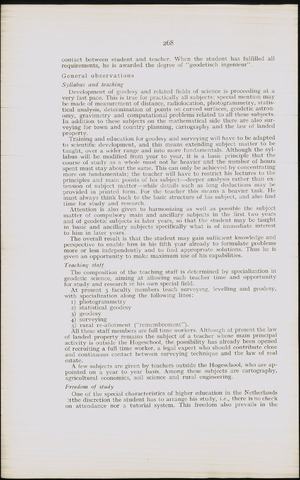268
contact between student and teacher. When the student has fulfilled all
requirements, he is awarded the degree of "geodetisch ingenieur".
General observations
Syllabus and teaching
Development of geodesy and related fields of science is proceeding at a
very fast pace. This is true for practically all subjects; special mention may
be made of measurement of distance, radiolocation, photogrammetry, statis
tical analysis, determination of points on curved surfaces, geodetic astron
omy, gravimetry and computational problems related to all these subjects.
In addition to these subjects on the mathematical side there are also sur
veying for town and country planning, cartography and the law of landed
property.
Training and education for geodesy and surveying will have to be adapted
to scientific development, and this means extending subject matter to be
taught, over a wider range and into more fundamentals. Although the syl
labus will be modified from year to year, it is a basic principle that the
course of study as a whole must not be heavier and the number of hours
spent must stay about the same. This can only be achieved by concentrating
more on fundamentals; the teacher will have to restrict his lectures to the
principles and main points of his subjectdeeper analysis rather than ex
tension of subject matterwhile details such as long deductions may be
provided in printed form. For the teacher this means a heavier task. He
must always think back to the basic structure of his subject, and also find
time for study and research.
Attention is also given to harmonizing as well as possible the subject
matter of compulsory main and ancillary subjects in the first two years
and of geodetic subjects in later years, so that the student may be taught
in basic and ancillary subjects specifically what is of immediate interest
to him in later years.
The overall result is that the student may gain sufficient knowledge and
perspective to enable him in his fifth year already to formulate^ problems
more or less independently and to find appropriate solutions. I hus he is
given an opportunity to make maximum use of his capabilities.
Teaching staff
The composition of the teaching staff is determined by specialization in
geodetic science, aiming at allowing each teacher time and opportunity
for study and research in his own special field.
At present 5 faculty members teach surveying, levelling and geodesy,
with specialization along the following lines:
1) photogrammetry
2) statistical geodesy
3) geodesy
4) surveying
5) rural re-allotment ("remembrement").
All these staff members are full time workers. Although at present the law
of landed property remains the subject of a teacher whose main principal
activity is outside the Hogeschool, the possibility has already been opened
of recruiting a full time worker, a legal expert who should contribute close
and continuous contact between surveying technique and the law of real
estate.
A few subjects are given by teachers outside the Hogeschool, who are ap
pointed on a year to year basis. Among these subjects are cartography,
agricultural economics, soil science and rural engineering.
Freedom of study
One of the special characteristics of higher education in the Netherlands
ifthe discretion the student has to arrange his study, i.e., there is no check
on attendance nor a tutorial system. This freedom also prevails in the

